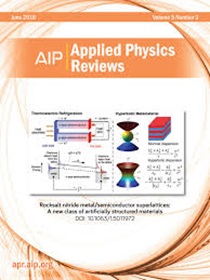Achieving high-performance organic photodetectors with novel interpenetrated heterojunction architectures
IF 11.6
1区 物理与天体物理
Q1 PHYSICS, APPLIED
引用次数: 0
Abstract
Heterojunctions are indispensable for fabricating high-performance organic photodetectors. However, traditional structures—such as planar heterojunctions (PHJs) and bulk heterojunctions (BHJs)—face significant challenges. PHJs often suffer from limited exciton dissociation in thick films, while BHJs experience considerable charge transport barriers. Although quasi-planar heterojunctions have been proposed to address these issues, controlling their nanoscale interface remains complex and material-dependent, limiting their applications. Herein, we introduce novel interpenetrated heterojunctions (IPHJs), formed by penetrating a secondary organic semiconductor layer into a porous bottom layer during annealing. This innovative structure is revealed to possess efficient exciton dissociation and charge transport. Remarkably, organic photodiodes (OPDs) featuring PM6:N2200 IPHJs demonstrate exceptional performance, achieving a responsivity (R) of 36.5 A/W, a specific detectivity (D*) of 8.6 × 1012 Jones, and a response time (τ) of 30 μs, representing state-of-the-art performance for OPDs. Furthermore, extending the IPHJ concept to tri-layer interpenetrated heterojunctions (T-IPHJs) shows significant promise for organic phototransistor applications. The PM6:N2200 T-IPHJ devices exhibit a responsivity exceeding 44.7 A/W, a D* value reaching 5.23 × 1014 Jones, and a τ of 70 ms. These results show the potential of IPHJs to advance the field of high-performance organic photodetectors and related devices.采用新型互穿异质结结构实现高性能有机光电探测器
异质结是制造高性能有机光电探测器必不可少的材料。然而,传统的结构,如平面异质结(phj)和块状异质结(bhj),面临着巨大的挑战。phj通常在厚膜中受到有限的激子解离的影响,而bhj则经历了相当大的电荷传输障碍。虽然准平面异质结已经被提出来解决这些问题,但控制其纳米级界面仍然很复杂并且依赖于材料,限制了它们的应用。在此,我们引入了一种新的互穿异质结(iphj),它是通过在退火过程中将二次有机半导体层穿透到多孔的底层而形成的。这种创新结构具有有效的激子解离和电荷输运。值得注意的是,采用PM6:N2200 iphj的有机光电二极管(opd)表现出优异的性能,响应率(R)为36.5 a /W,比探测率(D*)为8.6 × 1012 Jones,响应时间(τ)为30 μs,代表了opd的最先进性能。此外,将IPHJ概念扩展到三层互穿异质结(t -IPHJ)显示出有机光电晶体管应用的重大前景。PM6:N2200 T-IPHJ器件的响应率超过44.7 a /W, D*值达到5.23 × 1014 Jones, τ为70 ms。这些结果显示了iphj在高性能有机光电探测器和相关器件领域的发展潜力。
本文章由计算机程序翻译,如有差异,请以英文原文为准。
求助全文
约1分钟内获得全文
求助全文
来源期刊

Applied physics reviews
PHYSICS, APPLIED-
CiteScore
22.50
自引率
2.00%
发文量
113
审稿时长
2 months
期刊介绍:
Applied Physics Reviews (APR) is a journal featuring articles on critical topics in experimental or theoretical research in applied physics and applications of physics to other scientific and engineering branches. The publication includes two main types of articles:
Original Research: These articles report on high-quality, novel research studies that are of significant interest to the applied physics community.
Reviews: Review articles in APR can either be authoritative and comprehensive assessments of established areas of applied physics or short, timely reviews of recent advances in established fields or emerging areas of applied physics.
 求助内容:
求助内容: 应助结果提醒方式:
应助结果提醒方式:


